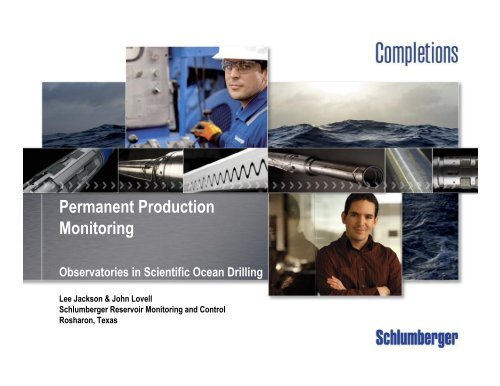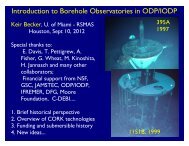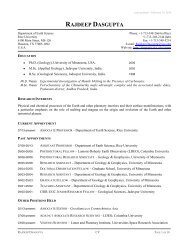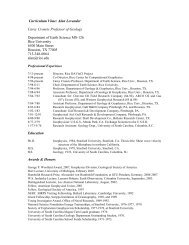Production Monitoring - Scientific Workshop Final.pptx
Production Monitoring - Scientific Workshop Final.pptx
Production Monitoring - Scientific Workshop Final.pptx
Create successful ePaper yourself
Turn your PDF publications into a flip-book with our unique Google optimized e-Paper software.
Permanent <strong>Production</strong><br />
<strong>Monitoring</strong><br />
Observatories in <strong>Scientific</strong> Ocean Drilling<br />
Lee Jackson & John Lovell<br />
Schlumberger Reservoir <strong>Monitoring</strong> and Control<br />
Rosharon, Texas
Drivers<br />
Recovery<br />
<br />
<br />
<br />
Reservoir Management driven<br />
Monitor and Evaluate <strong>Production</strong><br />
Optimize Drainage<br />
Update<br />
Model<br />
Reduced Intervention<br />
No loss of production<br />
Control<br />
Monitor<br />
Reduced risk<br />
Real Time Evaluation<br />
Combined with Flow Control devices<br />
allows for immediate corrective actions.<br />
Inflow<br />
Inflow<br />
Inflow<br />
Inflow<br />
Optimization<br />
Inflow<br />
Inflow<br />
Inflow
The Early Days<br />
• First Examples of Permanent<br />
<strong>Production</strong> monitoring date back to<br />
the early 1960’s<br />
• Data would be required for several<br />
weeks during production.<br />
• Reliability was questionable.<br />
• Early systems would monitor pressure<br />
only.<br />
3
Evolution<br />
1978 - First subsea<br />
wet mate connector<br />
deployment<br />
1972 - First<br />
permanent strain<br />
gauge installation<br />
(SPE 18357)<br />
1962 - Analog logging<br />
gauge run on wireline<br />
cable<br />
1984 - First HP quartz<br />
gauge developed<br />
1989 – SLB<br />
technology project for<br />
"Permanent<br />
<strong>Monitoring</strong>" initialized<br />
1993 - Permanent<br />
Quartz Gauge<br />
(PQG)<br />
commercialized<br />
1992 - First remote<br />
data communication<br />
2003 - Revolution<br />
in electrical<br />
connectors with<br />
Intellitite* series<br />
2005 - Combining<br />
downhole gauges<br />
with DTS in hybrid<br />
“NEON” cables<br />
2006 - WellNET<br />
downhole network<br />
system<br />
commercialized<br />
2004 - NET series<br />
generation of digital<br />
gauges<br />
2008 - Electrical<br />
systems for<br />
distributed sandface<br />
measurements<br />
1970 1980 1990 2000 2010<br />
2011 - New series of<br />
gauges with<br />
increased multidropping<br />
capabilities<br />
2010 - Gauge<br />
reliability<br />
improvement<br />
program<br />
2012 - New<br />
generation of<br />
WellNET platform for<br />
advanced IC systems
Current Technology<br />
Pressure and temperature gauges<br />
• Quartz and Sapphire gauges<br />
• Ultra Low power SOI Gauges<br />
• Fiber-optic P/T gauge<br />
Distributed measurements<br />
• Optical DTS (pumped or fixed fiber cable)<br />
• Electrical sensor array system<br />
300<br />
(572)<br />
250<br />
(482)<br />
200<br />
( 392 )<br />
175<br />
( 347 )<br />
150<br />
( 302 )<br />
100<br />
( 212 )<br />
50<br />
( 122 )<br />
0<br />
0<br />
Quartz Gauges<br />
Sapphire Gauges<br />
Fiber Optic Gauges<br />
Conventional<br />
NLQG-10<br />
NDPG-10<br />
Espionage<br />
Electrical Gauges<br />
NPQG-16<br />
Fiber Optic Gauge<br />
Ultra HP HT<br />
345<br />
690<br />
1 034<br />
1 379<br />
1724<br />
( 5 000 ) ( 10 000 ) ( 15 000 ) ( 20 000 ) ( 25 000 )<br />
Working<br />
Pressure<br />
HP<br />
HT<br />
Fiber-optic gauge<br />
NHQG-25<br />
2068<br />
( 30 000 )<br />
Enablers<br />
• Wellsite RT Connectors<br />
• Acoustic Data Loggers<br />
• WaveGliders<br />
Future Technology<br />
• UHPT Electronic Gauges<br />
• Wireless Gauges
Downhole <strong>Monitoring</strong> Systems and Reliability<br />
Reliability<br />
System is a chain.<br />
All links must be functional for system to work.<br />
Downhole equipment<br />
Gauge, cable, protectors<br />
Surface and subsea equipment<br />
Wellhead outlet, wet connector, flying leads<br />
Acquisition card and SCM<br />
Client MCS / SCADA<br />
Compatible with system components from multiple suppliers<br />
(interfacing challenges)<br />
Project Management<br />
Critical to Long Term Reliability<br />
Subsea tree<br />
Wellhead outlet<br />
Wet connector<br />
Harness and stab<br />
Acq<br />
Cable splice<br />
SCM or<br />
Data<br />
Logger<br />
Packer penetration<br />
Flow control valve<br />
Gauge cable head<br />
Gauge and mandrel
Identifying Failure Modes<br />
Surviving<br />
1.0<br />
0.9<br />
0.8<br />
0.7<br />
2002-03<br />
2000-01<br />
1998-99<br />
1995-97<br />
0.6<br />
0.5<br />
1 2 3 4 5<br />
Run Time (in years)<br />
7
Identifying Failure Modes<br />
8
Schlumberger Permanent Gauge Survival
Industry Growth<br />
10
FloWatcher*<br />
Permanent Downhole Flow Metering System<br />
Applications<br />
• <strong>Production</strong> allocation<br />
• Well productivity and trend analysis<br />
• Interference testing<br />
• Pressure transient analysis<br />
• <strong>Monitoring</strong> efficiency of electrical<br />
submersible pumps (ESPs)<br />
• Problem diagnosis
Applications<br />
8 Single Sensor Gauges are<br />
deployed across the reservoir<br />
to monitor Gas/Oil and Water<br />
contact points.<br />
12
Applications<br />
5 Zone Intelligent Completion with <strong>Monitoring</strong> and Control<br />
13
Subsea Considerations<br />
In hydrocarbon subsea wells, many completions are deployed<br />
in separate stages so that the pressure integrity of each stage<br />
can be confirmed before the next stage is run in. Also<br />
simplifies any subsequent workover activity.<br />
This translates to the need of a “wet-mate” to join cables in<br />
one completion stage to the next.<br />
Such wet-mates have proven notoriously unreliable… so far<br />
14
Dual Stage Completion – Telemetry/Power Solution<br />
Inductive coupling transmits power and data<br />
No rotational alignment<br />
Tolerant of debris<br />
No exposed electrical contacts<br />
Contraction joint provides depth tolerance<br />
Snap-latch provides mechanical feedback<br />
Merges data onto existing P/T control line<br />
No additional subsea tree penetrations<br />
15
Sandface Array Technology Components<br />
Flux Station acts as a repeater.<br />
Quartz Gauges and multiple array on<br />
same twisted-pair control line<br />
Subsea card for SCM or DIU<br />
Spoolable array of miniaturized temperature<br />
sensors incorporated onto cable<br />
Inductive coupler for wireless power and<br />
data communication<br />
Wellhead outlet and wet-mate<br />
Able to power dozens of P/T gauges and<br />
spools of sensors (up to 600)<br />
Interpretation software to provide flow-profiling,<br />
fluid identification, etc
Case Studies of Subsea Arrays<br />
Cleanup data<br />
Cleanup data and Flow Profile<br />
Cross-flow before/aftercleanup<br />
Zonal Interference and <strong>Production</strong><br />
Flow Profile<br />
Test run showed leaking isolation valve
Multiwell Analysis for Reservoir Mapping<br />
Shut in<br />
Producing<br />
Original reservoir has sands<br />
penetrated by two wells
Multiwell Analysis for Reservoir Mapping<br />
Shut in<br />
Producing<br />
Interference analysis shows<br />
unexpected connectivity<br />
between two sand bodies
Subsea Geothermals<br />
Radical lateral variations in temperature
Reservoir Geothermal Possibilities<br />
4 o C 4 o C<br />
4 o C 4 o C<br />
OR<br />
Isothermal contours strongly<br />
driven by seabed<br />
Isotherms less strongly driven by<br />
seabed
Reservoir Temperature in these wells<br />
was Controlled By Sea Water Depth
Reservoir Geothermal Possibilities<br />
4 o C 4 o C<br />
4 o C 4 o C<br />
Sea-bed dominates – gives implications to the reservoir barriers
Long-term Methane Hydrate <strong>Monitoring</strong> <br />
Goal: characterize MH hydrate production process during dissociation (production test) <br />
To surface<br />
Orange ball<br />
Water Depth<br />
1,000m<br />
Wet-mate connector (Elec.)<br />
Wet-mate connector (Elec.)<br />
26” OH, 20” CH<br />
MH reservoir<br />
12-1/4”OH, 9-5/8”CH<br />
DTS optic line<br />
Well depth 370m<br />
MH reservoir<br />
60m<br />
TAS array line<br />
Clamp<br />
Distance from production well ~50m
Long-term Methane Hydrate <strong>Monitoring</strong> <br />
Goal: characterize MH hydrate production process during dissociation (production test) <br />
4. Surface <br />
DTS, Controller,<br />
Wet-mate<br />
TAS DTS Pressure<br />
Battery<br />
Cable Protector Vessel<br />
Connector for ROV<br />
2. Seafloor <br />
MT2<br />
<strong>Monitoring</strong> wells<br />
MT1<br />
3. Surface-seafloor <br />
MC<br />
<strong>Production</strong> well<br />
Surface System<br />
Water Depth<br />
1,000m<br />
Subsea<br />
Cable<br />
1. Downhole <br />
Well depth 370m
Measurement Specifications <br />
Optical DTS<br />
Digital TAS<br />
Measurement Range Entire wellbore Hydrate Zone of Interest<br />
Measurement Resolution 1m 2m<br />
Sensor Length 450m 390m<br />
Measurement Accuracy ±0.5ºC ±0.1ºC<br />
Measurement Resolution 0.01ºC 0.001ºC<br />
<strong>Monitoring</strong> Duration > 18 months (600D) During deployment &<br />
production test (only)
Resolution/Accuracy of Array<br />
1mdegC/10mins
System Connectivity Diagram<br />
3m <br />
Surface<br />
system on<br />
vessel<br />
Acoustic<br />
Transponder<br />
USB Storage<br />
TAS<br />
RS485 +<br />
Power<br />
WMC<br />
holder panel<br />
WMC<br />
Electrical<br />
(DTS)<br />
~ 1.5km<br />
3m <br />
Bulkhead<br />
4- Ports<br />
‘Orange Ball’<br />
Schlumberger<br />
Downhole<br />
Optical<br />
Splice<br />
Chamber<br />
DTS<br />
Controlline<br />
Electrical<br />
(TAS)<br />
Field splice <br />
Elec. Manual Mate <br />
Opt. pre-made splice
Conclusions<br />
Significant progress towards subsea reservoir monitoring:<br />
• Reliability (>10yr life) is now routine)<br />
• <strong>Production</strong> measurements moving from above the<br />
production packer, to data along the sandface.<br />
• Distributed measurement (electrical and optical) complement<br />
single-point data<br />
• Subsea hardware has been deployed in observation and<br />
production wells, with water communication by ROV,<br />
accoustic and hard-wired.<br />
29





